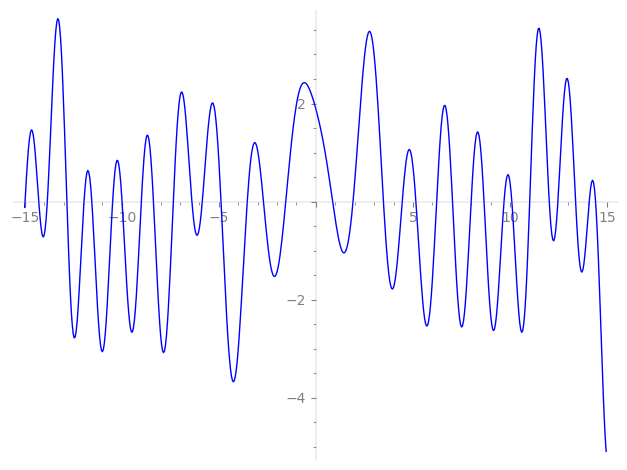| L(s) = 1 | + (1.14 + 1.91i)5-s + (0.642 + 2.56i)7-s + (2.01 − 1.16i)11-s + (0.104 − 0.104i)13-s + (3.64 + 0.977i)17-s + (−0.646 − 0.373i)19-s + (−1.75 + 0.471i)23-s + (−2.37 + 4.40i)25-s + 7.38·29-s + (0.668 + 1.15i)31-s + (−4.19 + 4.17i)35-s + (−6.66 + 1.78i)37-s − 0.0508i·41-s + (−3.06 + 3.06i)43-s + (−0.746 − 2.78i)47-s + ⋯ |
| L(s) = 1 | + (0.512 + 0.858i)5-s + (0.242 + 0.970i)7-s + (0.608 − 0.351i)11-s + (0.0289 − 0.0289i)13-s + (0.884 + 0.237i)17-s + (−0.148 − 0.0855i)19-s + (−0.366 + 0.0982i)23-s + (−0.474 + 0.880i)25-s + 1.37·29-s + (0.120 + 0.207i)31-s + (−0.708 + 0.705i)35-s + (−1.09 + 0.293i)37-s − 0.00794i·41-s + (−0.466 + 0.466i)43-s + (−0.108 − 0.406i)47-s + ⋯ |
Λ(s)=(=(1260s/2ΓC(s)L(s)(0.259−0.965i)Λ(2−s)
Λ(s)=(=(1260s/2ΓC(s+1/2)L(s)(0.259−0.965i)Λ(1−s)
| Degree: |
2 |
| Conductor: |
1260
= 22⋅32⋅5⋅7
|
| Sign: |
0.259−0.965i
|
| Analytic conductor: |
10.0611 |
| Root analytic conductor: |
3.17193 |
| Motivic weight: |
1 |
| Rational: |
no |
| Arithmetic: |
yes |
| Character: |
χ1260(737,⋅)
|
| Primitive: |
yes
|
| Self-dual: |
no
|
| Analytic rank: |
0
|
| Selberg data: |
(2, 1260, ( :1/2), 0.259−0.965i)
|
Particular Values
| L(1) |
≈ |
1.886361526 |
| L(21) |
≈ |
1.886361526 |
| L(23) |
|
not available |
| L(1) |
|
not available |
L(s)=p∏Fp(p−s)−1 | p | Fp(T) |
|---|
| bad | 2 | 1 |
| 3 | 1 |
| 5 | 1+(−1.14−1.91i)T |
| 7 | 1+(−0.642−2.56i)T |
| good | 11 | 1+(−2.01+1.16i)T+(5.5−9.52i)T2 |
| 13 | 1+(−0.104+0.104i)T−13iT2 |
| 17 | 1+(−3.64−0.977i)T+(14.7+8.5i)T2 |
| 19 | 1+(0.646+0.373i)T+(9.5+16.4i)T2 |
| 23 | 1+(1.75−0.471i)T+(19.9−11.5i)T2 |
| 29 | 1−7.38T+29T2 |
| 31 | 1+(−0.668−1.15i)T+(−15.5+26.8i)T2 |
| 37 | 1+(6.66−1.78i)T+(32.0−18.5i)T2 |
| 41 | 1+0.0508iT−41T2 |
| 43 | 1+(3.06−3.06i)T−43iT2 |
| 47 | 1+(0.746+2.78i)T+(−40.7+23.5i)T2 |
| 53 | 1+(0.248−0.926i)T+(−45.8−26.5i)T2 |
| 59 | 1+(−3.37−5.83i)T+(−29.5+51.0i)T2 |
| 61 | 1+(3.61−6.25i)T+(−30.5−52.8i)T2 |
| 67 | 1+(2.62−9.80i)T+(−58.0−33.5i)T2 |
| 71 | 1+12.8iT−71T2 |
| 73 | 1+(−10.9−2.94i)T+(63.2+36.5i)T2 |
| 79 | 1+(9.97+5.75i)T+(39.5+68.4i)T2 |
| 83 | 1+(0.461+0.461i)T+83iT2 |
| 89 | 1+(−2.21+3.83i)T+(−44.5−77.0i)T2 |
| 97 | 1+(−5.18−5.18i)T+97iT2 |
| show more | |
| show less | |
L(s)=p∏ j=1∏2(1−αj,pp−s)−1
Imaginary part of the first few zeros on the critical line
−9.984573212596237024866985147136, −8.992477465747398745947162674336, −8.367111180918252984136189018753, −7.34489065153569594582457171220, −6.38606455775029316604528229701, −5.85217748354744344150888441770, −4.88723599905737613048938713218, −3.53660993396302169448812062175, −2.69999420199489241660730104717, −1.55269245892348981710132955738,
0.861927074764382066671901683378, 1.91127401346962972640462465394, 3.47905732147217570244527732257, 4.44678486069065553881318326953, 5.15095665086919394396961522763, 6.21847741216002102223053605035, 7.03721635749029601538058820026, 7.996454129472163803076212602328, 8.661445470827627029448329019153, 9.690184497861766841969599449947

